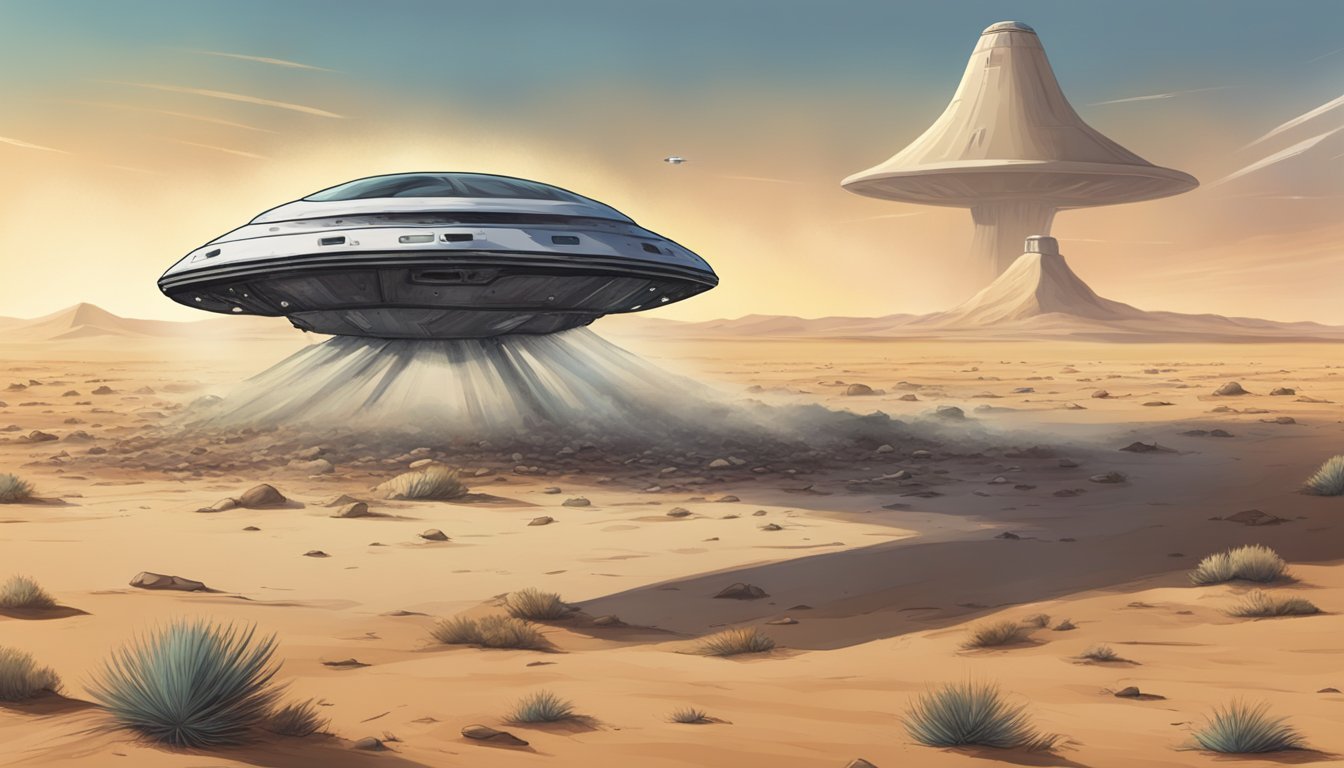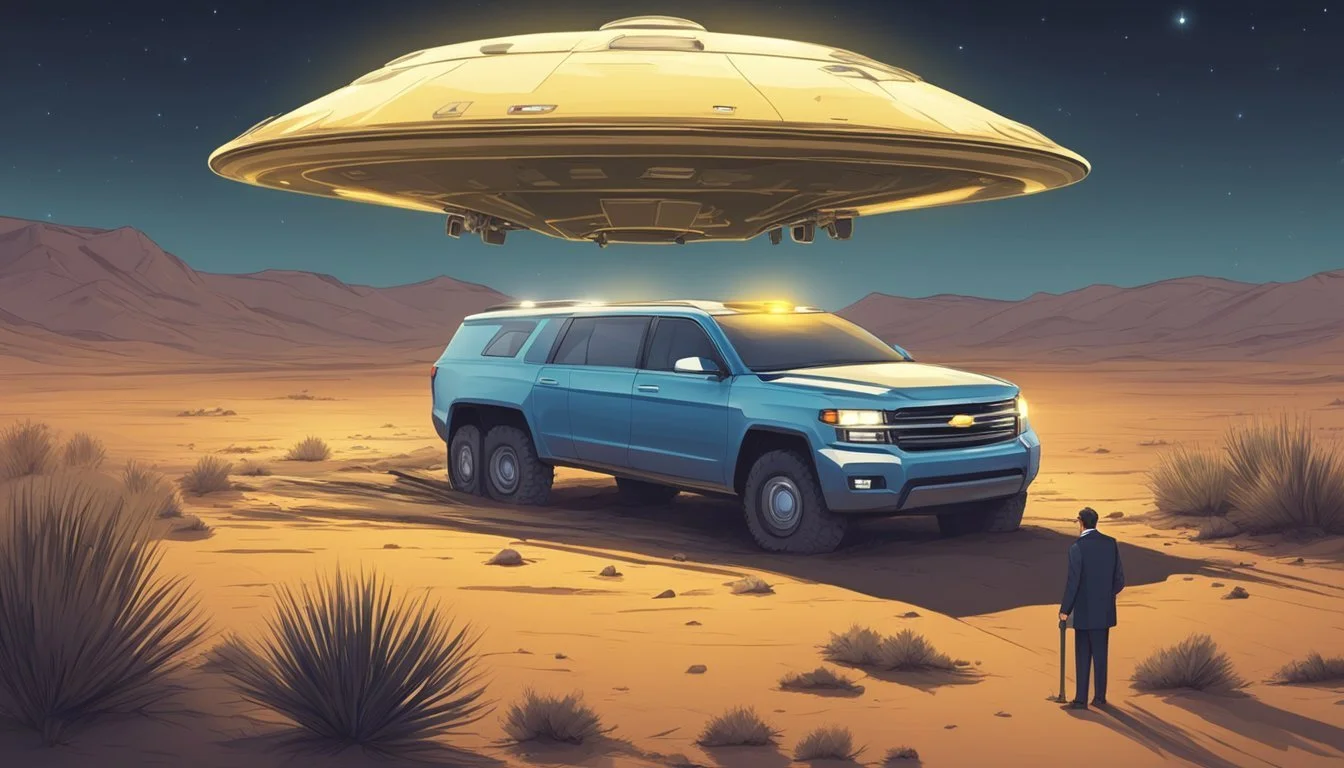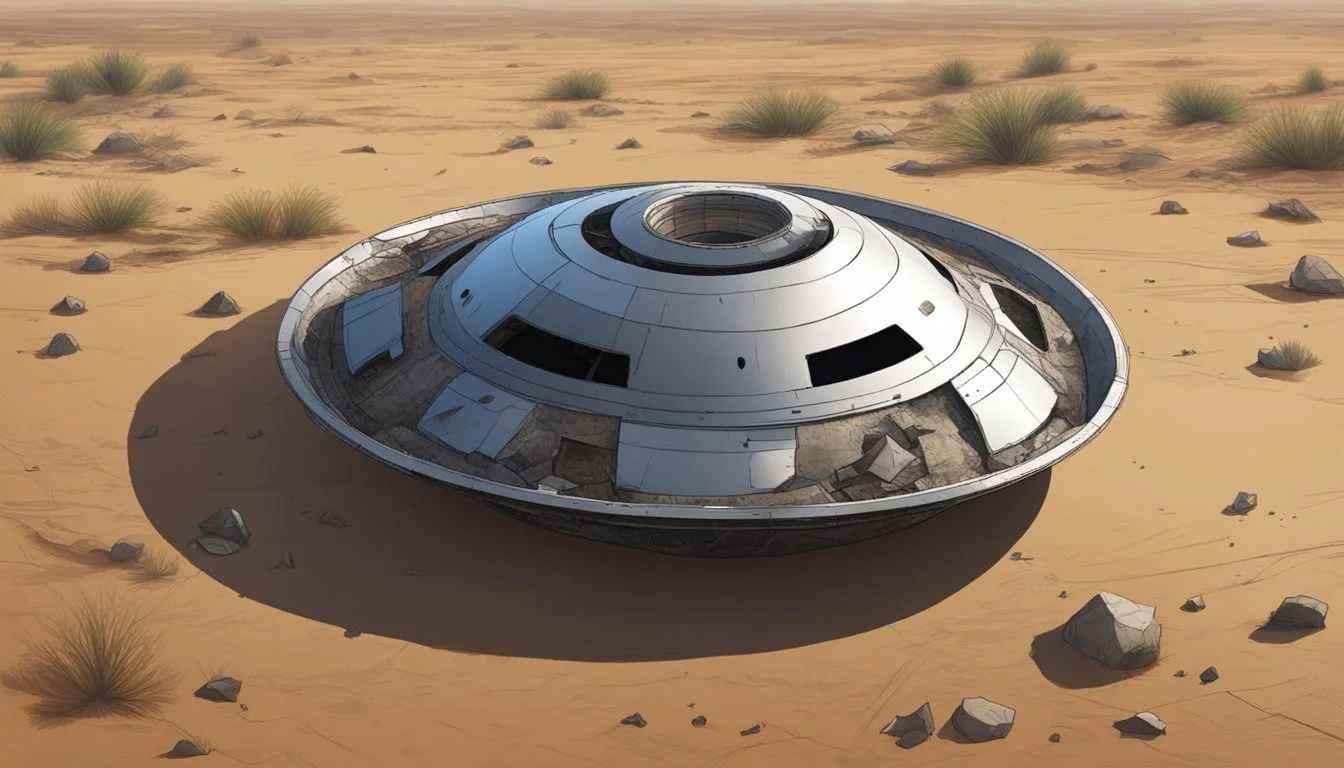The Infamous Roswell Incident Unveiled
New Evidence Emerges Decades Later
The Roswell UFO incident of 1947 remains one of the most famous and controversial events in UFO history. In early July of that year, unusual debris was discovered on a ranch near Roswell, New Mexico, sparking intense speculation about its origins. The U.S. military initially reported recovering a "flying disc" before quickly retracting the statement and claiming it was merely a weather balloon.
Eyewitness accounts and subsequent investigations have fueled decades of debate about what really happened in Roswell. Some believe the crash debris came from an extraterrestrial spacecraft, while skeptics maintain it was simply a top-secret military project. The incident has become deeply ingrained in popular culture, cementing Roswell's reputation as a hub for UFO enthusiasts.
Despite official explanations, questions persist about the true nature of the Roswell crash. The event continues to captivate the public imagination and inspire new theories. Whether one views it as a genuine UFO encounter or a misidentified mundane object, the Roswell incident remains a defining moment in UFO lore.
Historical Context of Roswell
The Roswell incident of 1947 marked a pivotal moment in UFO history. It occurred during a time of post-war tension and technological advancement in America, setting the stage for decades of speculation and conspiracy theories.
The Dawn of the UFO Phenomenon
In the late 1940s, reports of unidentified flying objects began to capture public attention across America. The term "flying saucer" entered popular lexicon after pilot Kenneth Arnold reported seeing strange objects in the sky near Mount Rainier in June 1947.
This sighting sparked a wave of similar reports nationwide. The Cold War climate fueled fears of potential Soviet technology or invasion. The U.S. Air Force initiated Project Sign in 1948 to investigate these sightings, later replaced by Project Grudge and Project Blue Book.
Roswell in the Late 1940s
Roswell, New Mexico, was a small town with a population of about 22,000 in 1947. It housed the Roswell Army Air Field, home to the 509th Bomb Group - the world's only atomic bomber unit at the time.
The town's economy relied heavily on agriculture, particularly cattle ranching and cotton farming. The presence of the military base brought economic benefits and heightened security awareness to the area.
On July 8, 1947, the Roswell Daily Record published a front-page article titled "RAAF Captures Flying Saucer On Ranch in Roswell Region". This headline thrust the quiet town into the international spotlight, forever changing its identity.
The Event of 1947
In July 1947, a mysterious incident occurred near Roswell, New Mexico that would spark decades of speculation and debate. The event involved unusual debris found on a ranch, military involvement, and conflicting explanations that fueled UFO theories.
Crash Details
On July 8, 1947, the Roswell Army Air Field issued a press release stating they had recovered a "flying disc" from a ranch northwest of Roswell. This announcement quickly spread through national news outlets, igniting public interest. The next day, the military retracted this statement, claiming the debris was actually from a weather balloon.
The exact nature of the crashed object remains disputed. Some eyewitness accounts described metallic materials with strange properties. Others reported seeing bodies at the crash site. The military maintained it was a top-secret high-altitude surveillance balloon from Project Mogul.
Rancher's Discovery
W.W. "Mac" Brazel, a rancher, first stumbled upon the debris field in early July while checking his sheep after a thunderstorm. He found unusual metallic fragments scattered over a large area. Brazel gathered some pieces and eventually reported his find to the local sheriff on July 7.
The sheriff contacted Roswell Army Air Field, which sent intelligence officer Jesse Marcel to investigate. Marcel collected debris samples and brought them back to the base. He later described the material as unlike anything he had seen before.
Brazel's discovery launched the Roswell incident into the public eye. His property became the focus of intense military and media scrutiny in the following days and weeks.
Government Involvement
The U.S. government played a central role in the Roswell incident, from the initial military response to later explanations and investigations. Their actions and statements shaped public perception and fueled decades of speculation about extraterrestrial involvement.
Initial Military Response
On July 7, 1947, rancher W.W. Brazel reported debris on his property near Roswell, New Mexico. The Roswell Army Air Field (RAAF) dispatched intelligence officer Major Jesse Marcel to investigate. Marcel collected samples and brought them to the base.
The military quickly cordoned off the area, restricting access to the crash site. Witnesses reported seeing armed guards and vehicles transporting large objects covered by tarps. Some locals claimed they were warned not to discuss what they had seen.
The swift and secretive nature of the military's actions raised questions about what exactly had been found on the Foster Ranch.
Press Release and Retraction
On July 8, 1947, the RAAF issued a press release stating they had recovered a "flying disc." This announcement made headlines across the country, sparking intense public interest in the incident.
The following day, the military dramatically changed its story. General Roger Ramey held a press conference, claiming the debris was actually from a weather balloon. He displayed materials that appeared to match this explanation.
This rapid reversal fueled suspicions of a cover-up. Many wondered why trained military personnel would mistake a common weather balloon for an extraterrestrial craft.
Project Mogul Explanation
In 1994, the U.S. Air Force released a report identifying the Roswell debris as part of Project Mogul, a top-secret program to detect Soviet nuclear tests using high-altitude balloons. The balloons carried acoustic sensors and radar reflectors made of unconventional materials.
The Air Force stated that the unusual appearance of these components, combined with security concerns, led to the initial confusion and subsequent secrecy. They asserted that witness accounts of alien bodies were likely misidentifications of test dummies used in later parachute experiments.
Critics argue this explanation fails to account for all witness testimonies and the military's initial actions. The debate over what really happened at Roswell continues to this day.
Eyewitness Accounts and Investigations
The Roswell incident sparked numerous eyewitness accounts and subsequent investigations. Multiple individuals claimed to have seen debris, unusual materials, and even alien bodies at the crash site. These testimonies formed the basis for decades of research and speculation about what truly occurred.
Firsthand Testimonies
Major Jesse Marcel, an intelligence officer at Roswell Army Air Field, was among the first to inspect the crash site. He described the debris as unlike anything he had ever seen before, with unusual properties and markings. Rancher Mac Brazel, who discovered the wreckage on his property, initially thought it was a weather balloon but later expressed doubts about its origin.
Several military personnel reported seeing strange metallic materials that were incredibly lightweight yet impossible to bend or break. Some witnesses claimed to have observed small bodies with large heads and eyes being transported from the crash site.
Subsequent Investigations
The U.S. Air Force conducted multiple investigations into the Roswell incident. In 1994, they released a report concluding that the debris was likely from a top-secret Project Mogul balloon designed to detect Soviet nuclear tests. This explanation was met with skepticism by UFO researchers and some eyewitnesses.
Independent investigators have continued to examine the case, interviewing witnesses and analyzing available evidence. Some claim to have uncovered classified documents and photographs supporting the extraterrestrial hypothesis. However, the lack of physical evidence and conflicting accounts have made definitive conclusions elusive.
Efforts to uncover the truth about Roswell persist, with new testimonies and potential evidence still emerging decades after the incident. The ongoing investigations keep the mystery alive and fuel continued debate about what really happened in the New Mexico desert in 1947.
Physical Evidence
The Roswell incident yielded physical debris that became the subject of intense scrutiny and analysis. Witnesses reported unusual materials with extraordinary properties, sparking decades of controversy and speculation about their origin.
Recovered Debris
The debris field northwest of Roswell contained scattered fragments over a large area. Rancher William "Mac" Brazel discovered strange metallic pieces on his property in early July 1947. He described thin, lightweight materials that couldn't be cut or burned.
Some witnesses reported memory metal that returned to its original shape when crumpled. Others described small beams with unusual hieroglyphic-like markings. The U.S. Army Air Forces quickly collected and removed the debris.
Major Jesse Marcel, the intelligence officer who first examined the site, later claimed the materials were unlike anything he had ever seen before.
Material Analysis
Initial analysis of the recovered materials proved inconclusive. Some debris displayed properties inconsistent with known terrestrial alloys of the time.
Witnesses described extremely thin but strong metal foils and small structural beams. These allegedly exhibited unusual strength-to-weight ratios and resistance to cutting or burning.
The U.S. government maintains the debris came from a top-secret Project Mogul high-altitude balloon used to detect Soviet nuclear tests. Critics argue this explanation doesn't account for all reported material properties.
Independent researchers claim some fragments showed isotopic ratios inconsistent with Earth-origin materials. However, no conclusive proof of extraterrestrial origin has been widely accepted by the scientific community.
The UFO Community and Conspiracy Theories
The Roswell incident sparked intense interest in UFOs and extraterrestrial life. This led to the emergence of UFOlogy and various conspiracy theories about government cover-ups of alien encounters.
Rise of UFOlogy
UFOlogy gained traction in the 1960s and 1970s as enthusiasts revisited earlier UFO reports. They focused on cases like Roswell, seeking evidence of alien visitation. UFO research groups formed, collecting witness testimonies and alleged physical evidence.
Books and documentaries fueled public fascination with UFOs. Notable works included "Incident at Exeter," which briefly mentioned Roswell. UFO conferences and conventions became popular, allowing researchers to share findings and theories.
Many UFOlogists believed governments possessed secret knowledge about extraterrestrial life. This suspicion drove efforts to uncover classified documents and interview military personnel involved in UFO incidents.
Government Conspiracy Theories
Conspiracy theories about government cover-ups of UFO evidence proliferated. The Roswell incident became a cornerstone of these beliefs. Theorists claimed the U.S. military recovered alien bodies and spacecraft debris from the crash site.
Some alleged the government established secret programs to reverse-engineer alien technology. Others believed in underground bases where aliens and humans worked together. These theories often pointed to unexplained phenomena and inconsistencies in official statements as proof of deception.
Declassified documents and whistleblower testimonies fueled speculation. However, skeptics argued that misidentified conventional objects or natural phenomena could explain most UFO sightings. The debate between believers and skeptics continues to shape UFO discourse.
Implications and Cultural Impact
The Roswell incident profoundly shaped public perceptions of UFOs and extraterrestrial life. It sparked intense debate, fueled conspiracy theories, and left an indelible mark on popular culture.
Roswell in Popular Culture
The Roswell incident inspired countless books, movies, TV shows, and video games. "The X-Files" TV series featured Roswell prominently, cementing its place in sci-fi lore. Hollywood films like "Independence Day" and "Paul" referenced the event, often portraying government cover-ups and alien encounters.
Music also embraced the Roswell theme. Country singer Merle Haggard released "The Day the Flying Saucer Landed" in 1988. Rock bands like Foo Fighters named themselves after UFO-related phenomena.
Comic books and graphic novels frequently explored Roswell themes. Marvel Comics introduced alien races connected to the incident, while independent publishers created entire series based on the event.
Legacy and Tourism
Roswell transformed from a small military town into a global UFO tourism hotspot. The International UFO Museum and Research Center, founded in 1991, attracts over 200,000 visitors annually. It houses exhibits on the 1947 incident and general UFO lore.
The annual UFO Festival, held each July, draws thousands of enthusiasts and curious tourists. Local businesses capitalize on the alien theme, with UFO-shaped streetlights and extraterrestrial-themed stores lining the streets.
Roswell's economy benefits significantly from UFO tourism. Hotels, restaurants, and gift shops cater to visitors seeking an otherworldly experience. The incident's legacy extends beyond tourism, influencing scientific research and public discourse on extraterrestrial life.
Modern Perspective
The Roswell incident continues to captivate researchers and the public alike. Recent scientific advancements and ongoing debates have shed new light on the events of 1947, challenging both skeptics and believers to reassess their positions.
Recent Analysis and Debates
Modern forensic techniques offer potential new insights into the Roswell case. Some experts advocate for applying these methods to the crash site, believing they could uncover previously overlooked evidence. Advanced material analysis and geological surveys might reveal anomalies or artifacts that were not detectable with 1940s technology.
The debate between skeptics and UFO researchers remains active. Skeptics point to declassified government documents and testimony from former military personnel to support the weather balloon explanation. UFO researchers, however, argue that these official accounts are part of an ongoing cover-up.
Public interest in the Roswell incident persists, as evidenced by the annual UFO festival in New Mexico. This event draws thousands of visitors and keeps the discussion alive. The incident's impact on popular culture is undeniable, inspiring countless books, films, and TV shows.



